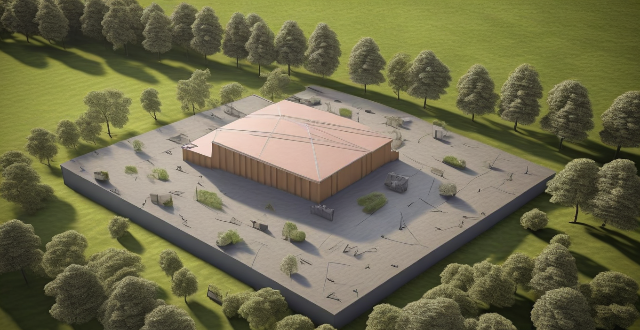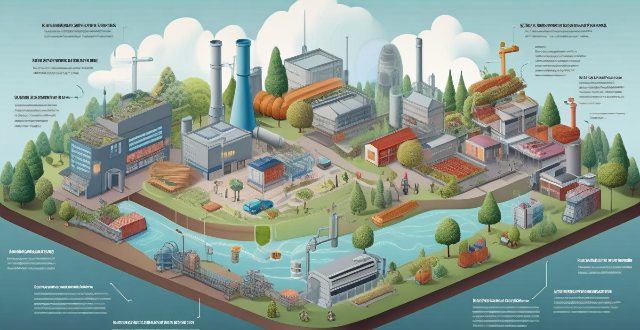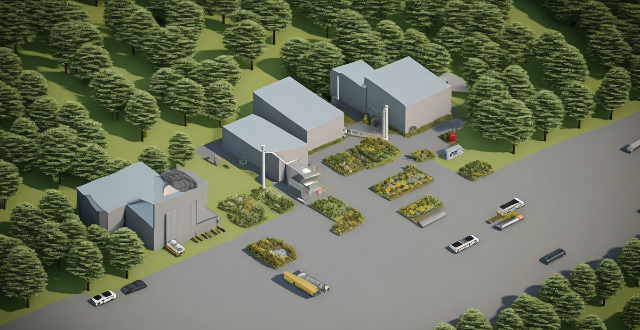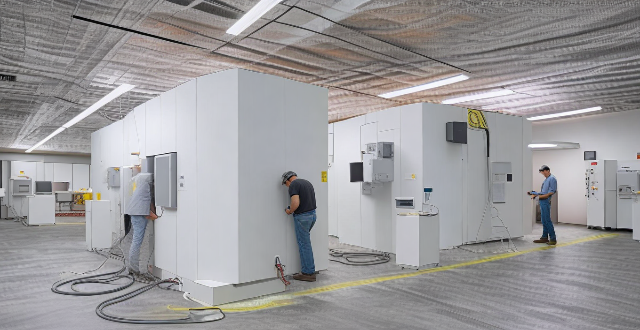Base Factors

How many communication base stations are needed to cover a city ?
This article discusses the factors affecting the number of communication base stations required for a city, including city size and population density, topography, and building height. It also provides an estimate formula to calculate the number of base stations needed based on city area and coverage per station. The conclusion emphasizes the importance of considering these factors in network planning and deployment to ensure reliable communication services across the city.

How do communication base stations affect the quality of phone calls and internet speeds ?
The article discusses the impact of communication base stations on phone call quality and internet speeds. It covers factors such as signal strength, coverage area, network congestion, spectrum availability, and technology used in base stations. The article explains how these factors affect voice and data services, and suggests solutions to address network congestion and improve performance.

How do communication base stations work ?
Communication base stations, or cell towers, are vital for wireless networks. They consist of antennas, transceivers, controllers, and power supplies to transmit and receive signals. The process includes encoding user data, modulating it onto RF waves, transmitting via antenna arrays, receiving by mobile devices, and decoding back to the original format. Coverage areas depend on antenna height, power, and topography, while handover processes ensure seamless transitions between base stations. Connected to a core network via backhaul links, base stations enable voice calls, messages, and data services, adapting to technological advancements to meet increasing demands.

What is the range of a typical communication base station ?
The typical communication base station, also known as aThe typical communication base station, also known as a specific geographic area with wireless The range of a base station can vary based on the type of technology used, the height and location of the tower, and the surrounding environment. Different technologies have different range capabilities, with newer ones like 4G and 5G offering greater coverage and capacity than older technologies like 2G. Tower height and location also play a significant role in determining its range, with taller towers covering wider areas and being less affected by signal blockage. The surrounding environment, including urban or rural areas, can impact the range of a base station. The typical range of a base station can be from a few hundred meters to several kilometers, with practical ranges often being smaller due to interference and other factors. Network operators may use multiple base stations and other techniques to optimize coverage and capacity within their service areas.

What kind of living conditions can we expect in a lunar base ?
Living on the Moon presents numerous challenges that must be addressed to create a sustainable environment for humans. These include dealing with low gravity, lack of atmosphere, limited water and food resources, waste management, power generation, and communication with Earth. Advancements in technology and scientific research are making it increasingly feasible to establish a lunar base, paving the way for future discoveries and expansion into space.

How do I get started in base jumping ?
Base jumping is an extreme sport that requires a high level of physical fitness, mental fortitude, and proper training. To get started in base jumping, one should evaluate their fitness level, research and learn about the sport, take a course from a reputable instructor or organization, practice skydiving (with at least 50 jumps), choose high-quality gear specifically designed for base jumping, start small with lower altitude jumps, find a mentor for guidance, join a community of base jumpers for support and learning opportunities, and continuously seek out new information and safety protocols to stay safe.

How can I achieve a flawless base without looking cakey ?
Achieving a flawless base is every makeup enthusiast's dream. However, it can be challenging to get the perfect balance between coverage and avoiding a cakey appearance. In this guide, we will discuss some tips and techniques to help you achieve a flawless base without looking cakey. The first step in achieving a flawless base is understanding your skin type. Different skin types require different products and techniques to achieve the desired look. Here are some general guidelines for each skin type: - **Oily Skin**: Use oil-free or mattifying primers and foundations to control shine and prevent slipping. Set with a loose powder to absorb excess oil. - **Dry Skin**: Moisturize well before applying makeup and use hydrating primers and foundations that won't cling to dry patches. Avoid setting with powder on areas that tend to flake or peel. - **Combination Skin**: Use a lightweight, hydrating primer on dry areas and an oil-controlling one on oily areas. Choose a foundation that works well with both skin types and set with a translucent powder where needed. - **Sensitive Skin**: Look for hypoallergenic and fragrance-free products to avoid irritation. Test new products on a small area of skin before using them all over your face. Proper skin preparation is key to achieving a flawless base. Follow these steps before applying makeup: 1. **Cleanse**: Start by washing your face with a gentle cleanser suitable for your skin type. 2. **Tone**: Use a toner to balance your skin's pH level and prepare it for moisturizer. 3. **Moisturize**: Apply a lightweight moisturizer that suits your skin type, focusing on any dry areas. 4. **Prime**: Choose a primer that addresses your specific concerns (e.g., pore-filling, illuminating, mattifying) and apply it evenly across your face. Selecting the right foundation is crucial for achieving a flawless base without looking cakey. Consider the following factors when choosing a foundation: - **Coverage**: Determine how much coverage you need based on your concerns (e.g., blemishes, redness, discoloration). Lightweight formulas like tinted moisturizers or BB creams offer sheer coverage, while full-coverage foundations provide more substantial concealment. - **Finish**: Choose a finish that complements your skin type and desired look (e.g., dewy, matte, natural). Oily skin may prefer a matte finish, while dry skin may benefit from a dewy or satin finish. - **Shade**: Find a shade that matches your skin tone exactly. Test foundations on your jawline in natural light to ensure a seamless blend with your neck. Once you've selected the right foundation, it's time to apply it using the following techniques: 1. **Start with Less**: Begin by applying a small amount of foundation to your face and build up coverage as needed. This helps prevent over-application and ensures a more natural look. 2. **Use the Right Tools**: Choose tools that work best for your foundation type (e.g., brushes for liquid formulas, sponges for cream or mousse textures). Dampen your sponge slightly if using one to help sheer out the product and avoid streakiness. 3. **Blend Well**: Blend the foundation thoroughly into your skin, paying extra attention to areas where it tends to collect or cling (e.g., around the nose, mouth, and eyes). Use downward strokes to avoid lifting the foundation off your skin. 4. **Set with Powder**: Set your foundation with a loose powder only where necessary (e.g., T-zone) to control shine and extend wear time. Be careful not to overdo it, as too much powder can make your base look cakey. After applying your foundation, you may still have some imperfections that need concealing. Here's how to do it without adding too much product: 1. **Use Concealer Sparingly**: Apply concealer only where needed (e.g., under eyes, blemishes) using a small brush or your fingertip. Tap the product into place rather than rubbing it vigorously. 2. **Set with Powder**: Set concealer with a translucent powder to prevent creasing and ensure longevity. Again, be cautious not to layer on too much powder.

What are the potential benefits of establishing a lunar base ?
**Heading: Potential Benefits of Establishing a Lunar Base** - **Advancements in Science and Technology:** Research opportunities in various fields, technological advancements in engineering and manufacturing, and testing new equipment for future missions. - **Economic Opportunities:** Job creation across industries, need for support staff, and the emergence of a new industry focused on lunar base operations. - **Energy Production:** Ideal location for solar power generation, potential for energy export to Earth, and development of efficient solar technology with Earth applications. - **Space Exploration and Travel:** Stepping stone for deeper space exploration, testing new propulsion systems and spacecraft designs, and paving the way for human settlements on other planets or moons. - **International Cooperation and Diplomacy:** Requirement for international collaboration, fostering diplomatic relations, promoting peaceful cooperation among nations, and encouraging global cooperation in addressing shared challenges.

What factors should be considered before choosing a celebrity to endorse a product ?
Before selecting a celebrity to endorse your product, itBefore selecting a celebrity to endorse your product, it several factors that can impact the it's crucial to consider several factors that can impact the success of your marketing campaign. These include the celebrity's image and reputation, target audience demographics and cultural relevance, popularity and influence, market research, cost versus benefit analysis, chemistry between brand and celebrity, and legal and ethical considerations. By carefully weighing these factors, you can select a celebrity endorser who will enhance the perceived value of your product and resonate with your intended customer base, ultimately driving brand awareness and sales.

What psychological factors contribute to the denial of environmental problems ?
The article discusses the psychological factors contributing to the denial of environmental problems. It mentions cognitive bias, emotional factors, and social influence as the main contributors to this issue. Cognitive bias includes confirmation bias and availability heuristic, which lead individuals to process information in a way that confirms their existing beliefs and values. Emotional factors such as fear, anger, and sadness can arise when confronted with environmental issues and lead to avoidance or denial. Social influence, including groupthink and social norms, can also contribute to the denial of environmental problems. Understanding these factors is crucial for promoting sustainable behavior and addressing environmental issues effectively.

What challenges need to be overcome to create a sustainable lunar base ?
Building a sustainable lunar base presents significant challenges in logistics, environment, technology, and human factors. These include reliable transportation, remote construction, surviving extreme conditions, power generation, effective communication, habitability concerns, health care, and team dynamics. Addressing these issues will require innovative solutions and international collaboration, ultimately paving the way for deeper space exploration.

What are some essential factors to consider when buying secondhand items ?
When purchasing secondhand items, several essential factors should be considered to ensure the best value for money. These include the condition of the item, its price, the reputation of the seller, authenticity, age and lifespan, and safety and legality. By considering these factors, buyers can make informed decisions and avoid potential pitfalls.

What is the cost of building and maintaining a communication base station ?
The article discusses the costs associated with building and maintaining a communication base station, categorizing them into initial setup costs such as site acquisition, design and engineering, equipment procurement, construction and installation, permits and licensing, and testing and commissioning, and ongoing maintenance costs like rent or lease expenses, power consumption, equipment maintenance, software updates, security measures, and staff salaries. It emphasizes the complexity of these processes and the importance of careful planning and budgeting for such projects.

How would a lunar base affect future space missions to Mars and other celestial bodies ?
A lunar base is expected to significantly impact future space missions, including those to Mars and other celestial bodies. The establishment of a permanent settlement on the Moon would lead to the development of new technologies, such as advanced propulsion systems and life support systems. These advancements would be crucial for future missions to Mars and beyond, where similar challenges would need to be addressed. A lunar base would also provide an opportunity to test and refine these technologies in a more controlled environment than Earth. Living on the Moon would have physiological and psychological effects on humans, such as changes in bone density and stress. By studying these effects and developing methods to mitigate them, scientists could better prepare astronauts for long-term missions to Mars and other celestial bodies. Additionally, understanding how humans adapt to living on the Moon could provide valuable insights into how they might adapt to living on other planets or moons. A lunar base would provide a closer location for logistical support and supply chain management compared to Mars or other celestial bodies. This proximity would allow for easier transportation of supplies, equipment, and personnel between Earth and the Moon, reducing costs and increasing efficiency. The establishment of a lunar base would also require the development of effective resupply and maintenance strategies that would be applicable to future missions to Mars and other celestial bodies. A lunar base would provide an excellent opportunity for training astronauts for future missions to Mars and other celestial bodies. By participating in simulated missions on the Moon, astronauts could gain valuable experience in operating in a low-gravity environment, performing scientific experiments, and maintaining their physical and mental health. The establishment of a lunar base would also require the development of new crew selection criteria that would consider factors such as physical fitness, psychological resilience, and technical skills. The establishment of a lunar base would likely generate increased global interest in space exploration, leading to greater international collaboration and partnerships. This collaboration could result in shared resources, expertise, and funding for future missions to Mars and other celestial bodies, reducing costs and increasing efficiency. International collaboration could also lead to the standardization of technologies and practices across different space agencies, reducing confusion and increasing the overall effectiveness of these missions. In conclusion, a lunar base would have a significant impact on future space missions to Mars and other celestial bodies. From advancements in technology and human adaptation to logistical support and international collaboration, a lunar base would provide valuable lessons and experiences that would help prepare astronauts for long-term missions beyond Earth's orbit. As such, the establishment of a lunar base should be seen as an essential step towards achieving our ultimate goal of exploring and settling other planets and moons in our solar system.

How are communication base stations maintained and upgraded ?
Maintaining and upgrading communication base stations is essential for reliable and efficient wireless network operation. Regular maintenance includes inspection, cleaning, software updates, and hardware replacement. The upgrade process involves need assessment, design, procurement, installation, configuration, testing, and deployment. Best practices include preventive maintenance, remote monitoring, training, documentation, and collaboration with vendors and service providers. By following these guidelines, network operators can ensure the smooth operation of their wireless networks.

What are the factors that contribute to climate vulnerability ?
Climate vulnerability is influenced by various factors that can exacerbate the impacts of climate change and limit the ability of systems to adapt, including exposure to extreme weather events and sea level rise, ecosystem sensitivity, economic resources, infrastructure resilience, population density, dependency on climate-sensitive sectors, policy frameworks, access to information and technology, traditional knowledge, awareness and education, biodiversity loss, and land use changes. Addressing these factors through comprehensive strategies is essential for building resilience against the challenges posed by a changing climate.

What are the key factors to consider when planning an education budget ?
The text provides a comprehensive guide on the key factors to consider when planning an education budget. These factors include student population, curriculum and program offerings, faculty and staff salaries, infrastructure and maintenance costs, technology and digital learning tools, professional development opportunities, student support services, community partnerships and collaborations, and contingency funding. By considering these factors, one can create a budget that meets the educational needs of students while staying within financial constraints.

How would a lunar base impact space exploration and research ?
**Impact of a Lunar Base on Space Exploration and Research** - **Advancements in Space Technology:** A lunar base would necessitate the development of advanced propulsion systems, life support systems, high-frequency communication systems, and precise navigational tools. - **Expansion of Scientific Knowledge:** The establishment could provide insights into lunar geology, resource identification, astrophysical observations through telescope installations, and monitoring of the solar system. - **Human Spaceflight Capabilities:** Long-term stays on the Moon would allow astronauts to adapt to low-gravity environments and conduct medical research, while also requiring specialized training programs and psychological preparation. - **International Collaboration and Policy Development:** A lunar base would encourage global partnerships, shared resources, and prompt the development of new space laws and ethical guidelines.

What are the key factors that contribute to social harmony ?
Social harmony is a state of peaceful coexistence and cooperation among individuals, groups, and communities within a society. Key factors contributing to social harmony include respect for diversity, communication and dialogue, education and awareness, equality and fairness, law and order, civic participation and volunteerism, and economic stability and prosperity. By promoting these factors, societies can create a more peaceful and cooperative environment where everyone can thrive.

What factors influence the performance of tech stocks ?
Tech stocks are influenced by macroeconomic conditions, industry-specific factors, and company-specific factors. Macroeconomic conditions include interest rates and economic growth. Industry-specific factors include regulatory changes and technological advancements. Company-specific factors include financial health and leadership and management.

What are the key factors that influence the economic success of a sports team or league ?
The economic success of a sports team or league is influenced by various factors, including fan base and attendance, broadcasting rights and media coverage, sponsorship and partnerships, player performance and talent management, marketing and branding, financial management, governance and leadership, and legal and regulatory framework. A loyal fan base ensures consistent ticket sales and merchandise purchases, while higher attendance rates lead to increased revenue from ticket sales. Lucrative broadcasting contracts and positive media coverage attract fans and sponsors alike. Corporate sponsors provide financial support, while strategic alliances with other brands expand marketing reach. Top players attract fans and improve team performance, while effective draft strategies ensure a steady stream of talented athletes. A strong brand resonates with fans and attracts commercial interest, while creative marketing campaigns generate buzz and drive sales. Efficient spending on operations and player salaries is crucial for financial success, as is diversifying revenue streams. Strong leadership sets the course for long-term success, while transparent governance fosters trust among stakeholders. Adhering to laws and regulations avoids financial penalties and reputational damage, while fair labor agreements ensure stability. Overall, these factors work together harmoniously to create a sustainable and thriving sports organization.

How might a lunar base influence the global economy and job market ?
The establishment of a lunar base could significantly impact the global economy and job market by increasing investment in space technology, creating new industries, driving innovation, and fostering international collaboration. It could also create numerous job opportunities and expand educational opportunities focused on space-related disciplines.

What factors determine the amount of a student loan ?
The amount of a student loan is determined by several key factors, including eligibility criteria set by the lender, the cost of attendance at the chosen school, the student's financial need, and the type of loan (federal or private). Other influential factors include repayment options, school choice, and the availability of other financial aid. Students should consider all these elements and explore all possible funding options before taking out a loan.

How would a lunar base contribute to humanity's understanding of the universe ?
A lunar base would significantly contribute to humanity's understanding of the universe by providing advanced research opportunities in geology and astronomy, driving the development of space technology, serving as a training ground for future space missions, and promoting international collaboration.

What factors should I consider before upgrading my broadband connection ?
This topic summary discusses the key factors to consider before upgrading a broadband connection, including speed requirements, data caps, reliability, cost, availability, customer support, and additional features. It emphasizes the importance of evaluating current internet usage, future needs, monthly limits, overage charges, downtime frequency, service outages, contract terms, pricing plans, provider options, infrastructure, service quality, user reviews, bundling opportunities, and security measures. The conclusion suggests that by considering these factors, one can make an informed decision that meets current needs and anticipates future changes in internet usage patterns.

What factors affect the price of a second-hand iPhone ?
The price of a second-hand iPhone is influenced by various product-related and market-related factors. Product-related factors include the condition, age, storage capacity, and accessories of the phone. Market-related factors encompass supply and demand dynamics, brand loyalty, perception of new models, economic conditions, and currency exchange rates. Understanding these factors can help buyers and sellers negotiate better prices in the second-hand market.

What factors affect the accuracy of climate model predictions ?
The accuracy of climate model predictions is influenced by various factors including data quality and availability, model complexity and resolution, initial conditions and parameterizations, natural variability and external forcing, and the use of model intercomparison and ensemble methods. High-quality, up-to-date data and comprehensive models that account for multiple physical processes and high-resolution details are crucial. Initial conditions, sub-grid scale process parameterizations, internal climate variability, and external forcing factors add layers of complexity and uncertainty. To mitigate these uncertainties, scientists employ intercomparison projects and ensemble forecasting techniques to assess model reliability and potential future climate scenarios.

How do psychological factors influence sports performance and research ?
This document discusses the influence of psychological factors on sports performance, emphasizing the importance of motivation, confidence, concentration, resilience, and team dynamics. It highlights how these elements can enhance or hinder athletic performance and underscores the significance of research in understanding and applying psychological principles to optimize athlete mental states. The text concludes by noting the potential for ongoing research to refine our comprehension and application of psychology in sports, aiming to help athletes achieve their full potential mentally and physically.

What are the health risks associated with living near a communication base station ?
Living near a communication base station, such as a cell tower or a radio mast, has raised concerns about potential health risks. While the scientific evidence is still being debated, there are several possible health effects that have been suggested by some studies and expert opinions. Here are some of the key health risks associated with living near a communication base station: - Electromagnetic Radiation Exposure: Increased exposure to electromagnetic fields (EMFs) and possible long-term effects on health. - Sleep Disruption: Disrupted sleep patterns and chronic sleep deprivation leading to various health issues. - Stress and Anxiety: Heightened stress levels and mental health impacts due to concerns about EMF exposure. - Environmental Impact: Noise pollution and visual pollution affecting both human health and wildlife.

How will a lunar base address issues related to Earth's overpopulation or resource depletion ?
A lunar base could address Earth's overpopulation and resource depletion by reducing population pressure, enabling sustainable resource use, advancing science and technology, and promoting international cooperation.